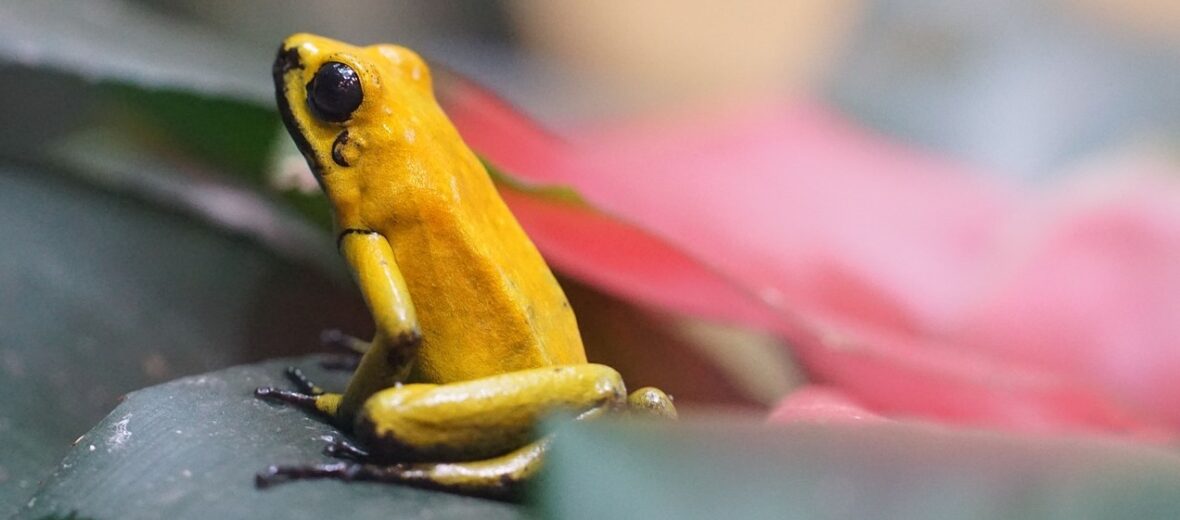
The golden poison frog, aka, poison frog, poison dart frog, or poison arrow frog, is the echelon of amphibian toxicity. Have you ever heard the saying, “You are what you eat”? Well, these frogs are living proof that this can be factual. Golden poison frogs can be found in the Pacific coast of Colombia in the Cauca and Valle del Cauca Departments in the Chocó Rainforest. I have personally had the opportunity to care for and breed these magnificent amphibians and they are a lot of fun to watch and work with. I even got the chance to raise and add a couple to the Aquarium of the Pacific’s dart frog collection. Unfortunately, these frogs are victims of over-collection by the pet trade. They also suffer from habitat loss, pollution, climate change, and the deadly chytrid fungus. Even though they are often called dart frogs, they should just be called poison frogs.
First the Stats…
Scientific name: Phyllobates terribilis
Weight: Up to .14 ounces
Length: Up to 2.4 inches
Lifespan: Up to 15 years
Now on to the Facts!
1.) These frogs are diurnal (active during the day).
2.) This poison dart frog is frequently mistaken for a mantella frog. However, mantellas live only in Madagascar, whereas dart frogs live in Central and South America. Both are poisonous, but mantella frogs will just make you sick; as they don’t pack enough poison strength to kill.
3.) Golden poison frogs are considered to be the most toxic vertebrate on the planet.
4.) Its poison is up to 20 times more potent than that of other dart frogs.
5.) The poisonous secretions, called batrachotoxin, are reported to be 200 times more powerful than morphine!
But wait, there’s more on the golden poison frog!
6.) They also go by the name terrible frog.
7.) Like all dart frogs, they prefer a humid and moist environment with plenty of access to water.
Did you know…?
It only takes the amount of poison, equal to about 3 grains of salt to kill a human!
8.) Females lay their eggs on the ground and the male transports them to standing water to begin their metamorphosis into adult frogs.
9.) Sadly, the constant destruction of their rainforest habitat has pushed them to the IUCN status of Endangered. And their populations are decreasing.
10.) Another threat they face is the deadly Chytrid fungus, which has wiped out entire species of amphibians.
But wait, there’s still more on the golden poison frog!
11.) Their Latin family name, Dendrobatidae, translates to “One who walks in the trees.”
12.) The poison is obtained from the invertebrates they prey on: mites and ants.
Did you know…?
The Choco people of western Colombia use the poison of the golden poison frog to coat the tips of their blow darts which are used for hunting birds and various mammals they need for food.
13.) Symptoms of their poison include: muscle contractions, convulsions, seizures, salivation, dyspnoea (the feeling of not being able to breathe), heart failure, fibrillation, and potential death. Although their poison is only effective upon introduction to the blood stream. Licking them will only leave a nasty taste in your mouth.
14.) They come in 3 colors: yellow, orange, and mint green.
15.) Only 1 creature can successfully prey on these frogs. A snake called Liophis epinephelus. They are apparently immune to the poison.
Now a Short Golden Poison Frog Video!
Be sure to share & comment below! Also, check out the Critter Science YouTube channel. Videos added frequently!
Want to suggest a critter for me to write about? Let me know here.



